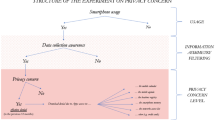By their very nature, awareness systems bring about an increase in the level of communication between the individuals they connect. Sharing information regarding people’s whereabouts and activities raises privacy concerns, potentially compromising their ability to control who receives what information about them, in what form and at what times. Such privacy concerns can be more pronounced in cases where such information is captured and disclosed automatically, which can lead to unintentional and undesirable disclosure of information (Belloti and Sellen, 1993; Markopoulos, 2005).
Access this chapter
Tax calculation will be finalised at checkout
Purchases are for personal use only
Similar content being viewed by others
Notes
- 1.
Other terms we use to represent track-II signals are: coordination signals, collateral signals or secondary signals.
References
Altman, I. (1975). The Environment and Social Behaviour – Privacy, Personal Space, Territory, Crowding. Monterey, CA, Wadsworth.
Aoki, P. M. and Woodruff, A. (2005). Making space for stories: ambiguity in the design of personal communication systems. In Proceedings of the SIGCHI Conference on Human Factors in Computing Systems, CHI '05. ACM, pp. 181–190.
Bellotti, V. and Sellen, A. (1993). Design for privacy in ubiquitous computing environments. In Proceedings of the Third Conference on European Conference on Computer-Supported Cooperative Work, ESCW ’93, pp. 77–92.
Boyle, M. and Greenberg, S. (2005). The language of privacy: learning from video media space analysis and design. ACM Transactions on Computer–Human Interaction (TOCHI), vol. 12(2), pp. 328–370.
Clark, H. (1996). Using Language. New York, Cambridge University Press.
Dourish, P., Adler, A., Bellotti, V., and Henderson, A. (1996). Your place or mine? Learning from long-term use of audio–video communication. Journal CSCW, vol. 5(1), pp. 33–62.
Markopoulos, P. (2005). Designing ubiquitous computer human interaction: the case of the connected family. In Isomaki, H., Pirhonen, A., Roast, C. and Saariluoma, P. (Eds.) Future Interaction Design. London, Springer, pp. 125–150.
Monk, A. (2003). Common ground in electronically mediated communication: Clark’s theory of language use. In Carroll, J. M. (Ed.)HCI Models, Theories and Frameworks: Towards a Multidisciplinary Science. San Francisco, CA, Morgan Kaufmann, pp. 265–289.
Nardi, B., Whittaker, S., and Bradner, E. (2000). Interaction and outeraction: instant messaging in action. In Proceedings of the 2000 ACM Conference on Computer Supported Cooperative Work, CSCW ’00. ACM, pp. 79–88.
Neustaedter, C., Greenberg, S., and Boyle, M. (2006). Blur filtration fails to preserve privacy for home-based video conferencing. ACM Transactions on Computer–Human Interaction, vol. 13(1), pp. 1–36.
Palen, L. and Dourish, P. (2003). Unpacking ``privacy’ for a networked world. In Proceedings of SIGCHI, PP. 129–136.
Petronio, S. (2002). Boundaries of Privacy: Dialectics of Disclosure. Albany, State of University of New York Press.
Reichenbach, M., Damker, H., Federrath, H., and Rannenberg, K. (1997). Individual management of personal reachability in mobile communication. In Proceedings of the IFIP TC11 SEC’97 on Information Security in Research and Business, pp. 164–174.
Romero, N.A. (2008). Coordination of interpersonal privacy in mediated communication. PhD Thesis, Eindhoven University of Technology.
Romero, N. A. and Markopoulos, P. (2005). Common ground to analyze privacy negotiation in awareness systems. In Human–Computer Interaction – INTERACT 2005. Lecture Notes in Computer Science, Rome, Italy, Springer, pp. 1006–1009.
Romero, N., Markopoulos, P., Baren, J., Ruyter, B., IJsselsteijn, W., and Farshchian, B. (2007). Connecting the family with awareness systems. Personal Ubiquitous Comput. Vol. 11(4),pp. 299–312.
Woodruff, A. and Aoki, P. M. (2003). How push-to-talk makes talk less pushy. In Proceedings of the 2003 International ACM SIGGROUP Conference on Supporting Group Work, GROUP ’03. ACM, pp. 170–179.
Zhao, Q. A. and Stasko, J. T. (1998). Evaluating image filtering based techniques in media space applications. In Proceedings of the 1998 ACM Conference on Computer Supported Cooperative Work, CSCW ’98. ACM Press, pp. 11–18.
Acknowledgments
This research was supported by the FP6 FET programme, project ASTRA IST-2004-29266 and the IP project 27654 PASION.
Author information
Authors and Affiliations
Editor information
Editors and Affiliations
Rights and permissions
Copyright information
© 2009 Springer-Verlag London Limited
About this chapter
Cite this chapter
Romero, N., Markopoulos, P. (2009). Grounding Privacy with Awareness: A Social Approach to Describe Privacy Related Issues in Awareness Systems. In: Markopoulos, P., De Ruyter, B., Mackay, W. (eds) Awareness Systems. Human-Computer Interaction Series. Springer, London. https://doi.org/10.1007/978-1-84882-477-5_9
Download citation
DOI: https://doi.org/10.1007/978-1-84882-477-5_9
Published:
Publisher Name: Springer, London
Print ISBN: 978-1-84882-476-8
Online ISBN: 978-1-84882-477-5
eBook Packages: Computer ScienceComputer Science (R0)




